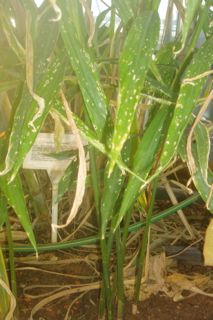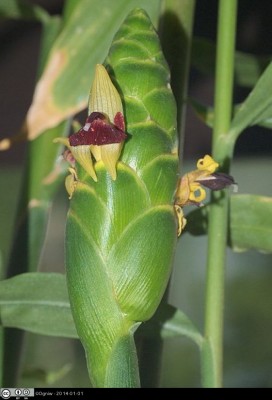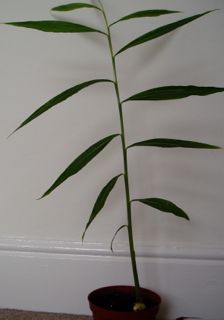In the cold, wet, dreary days of a British winter, a warming spice from a tropical country may be just the thing to lift the spirits. Valued both as a spice and as a medicinal herb in India and China since ancient times, Ginger, or Zingiber officinale, is one of the most popular spices worldwide and is widely used in food, medicines, drinks and toiletries around the globe.
In Europe, during the 13th and 14th centuries, it was second only to pepper (Piper nigrum) in its popularity and at the time of Henry VIII it was believed to ward off plague (Ravindrun and Babu, 2005; Purseglove, 1981). More recently, research has taken place into the medicinal properties of the plant and exciting new therapeutic applications are still being found.
Common Names
The Latin name, Zingiber is believed to derive from the ancient Tamil word, ingiver which basically means ginger rhizome. The plant currently has a large and diverse collection of common names reflecting its global popularity and in some languages, fresh and dried ginger have different names (Ravindrun and Babu, 2005).
| Language/Country | Common Names |
| Chinese | Jeung, Sang Keong, Chiang, Jiang, Keong, Shen Jiang |
| Hindi | Adi, Adrack (fresh), Sonth (dried) |
| Sanskrit | Adraka (fresh), Shunthi (dried), Nagavi |
| Indonesian | Jabe, Aliah, Jae, Lia |
| Vietnamese | Ung, Sinh Khuong |
| Malayasam | Inchi (fresh/plant), Chukku (dried) |
| European | Gember(Dutch), Gingembre (French), Ingwar (German), Zenzero (Italian), Jengibre (Spanish) |
| Pharmacological Name | Rhizoma zingiberis |
Table showing some of the common names for Zingiber officinale
Taxonomy
Although there is some uncertainty about its descent, Zingiber officinale is believed to be a cultigen of Indian origin (Mabberley, 1997). The first documented reference to the plant is in Hortus Indicus Malabaricus by Van Rheede, published 1678-1693 and translated into English in 2003 (Moham Ram, 2005), using the local Indian name of Inschi (Ravindran et al., 2005). The genus zingiber was described by Boehmer and Ludvig in 1790 with the assigned type species for the genus being Zingiber officinale and in 1810, Roxburg described eleven Indian zingiber species, dividing them into two groups. A much fuller survey of Indian Zingiberaceae was undertaken by Baker in 1882 for The Flora of British India by J. D. Hooker and the four subgeneric classifications he described were accepted by Schumann who revised the family Zingiberaceae in 1904 (Ravindran et al. 2005).
The plant we now know as ginger (Z. officinale) was first described by Linnaeus as Amonum zingiber, the basionym for the species, and the genus name Amonum remains a synonym for Zingiber Boehm (Burt and Smith, 1968, cited in Ravindrun et al. 2005)
In 1807, Roscoe, described the plant from a specimen in the Liverpool Botanic Garden, referring to Willdenow’s treatment, itself an extension of Linnaeus’ previous description. As the species name zingiber could not be used in the genus Zingiber, Z. officinale was adopted as the species name, and the lectotype assigned to Z. officinale Roscoe is that from Linnaeus’ Species Plantarum, 1753, thereby replacing an earlier lectotype by Van Rheede in Hortus Malabaricus 1692 which was found to be incorrect (Natural History Museum, 2006). The base of officinale is the Latin word Officina which means workshop or pharmacy in early Latin, alluding to the medicinal uses of the plant (Ravindran et al., 2005) while the epithet officinale or officinalis is a medieval Latin word used for medicinal substances, mostly from plants.
Until recently, the family was divided into four tribes: Hedychiaeae, Alpinaeae, Zingibereae and Globbeae but a study of the phylogeny of Zingiberaceae, undertaken by Kress (Kress et al., 2002) resulted in a rearrangement of the Zingiberaceae into four subfamilies: Siphonochoideae, Tamijoideae, Alpinoideae and Zingiberoideae. This classification has now been adopted by the Angiosperm Phylogeny Group (Stevens, 2001).
Plant Description
Z. officinale is a herbaceous perennial comprising a rhizome, fibrous roots and aerial shoots. The aerial shoots are pseudostems consisting of many narrow leaves borne on very short petioles, with overlapping sheaths at the bases and can reach 1.5m in height. Leaf blades are 5-30cm long and 8-20mm wide with ligules present at the junction of leaves and sheaths (World Health Organisation, 2000). The leaves are lanceolate, distichous and glabrous with a prominent midrib. The underground stem or rhizome has a fleshy, yellow interior with secretory cells and ethereal oils. Nodes are present along the stem, which, apart from the first few, bear axillary buds which develop, allowing the rhizome to enlarge following a sympodial growth pattern (Ravindrun et al., 2005; Mabberley, 1997)
Both fibrous and fleshy roots are present; the fibrous roots, with root hairs, provide absorption of water and nutrients whilst the thicker, fleshy roots also provide stability. The flowering spikes, or scapes, which arise directly from the rhizome, are formed of overlapping bracts, each of which contains a single axillary flower encircled by a scarious bracteole.
Flowering, which is probably dependent on climatic and cultivation factors, is not common and when it does occur, the insect pollinated inflorescence is ephemeral.The ginger in the tropical glasshouse at Reading flowered for over 6 months shortly after planting.
A characteristic of the ginger flower is the colourful labellum (petaloid stamen). The single, remaining anther is free and fertile; the inferior ovary globose; the tubular corolla divided into three lobes at the top and the style is long (Ravindran et al., 2005).
The fruit is a loculicidally dehiscent fleshy capsule containing seed with a distinctive white aril (Heywood et al., 2007; Ravindrun et al., 2005; Mabberley, 1997).
Medicinal Usage
Z. officinale has a long history as a medicinal herb going back to ancient Greek and Roman times and is used, in both fresh and dried states, as a home remedy in almost all countries where it is cultivated (Williamson, 2002; Mabberley, 1997).
The plant is arguably the most widely used herb in the traditional Indian system of medicine known as Ayurveda where it is referred to as Mahaousbadba (great cure) and Visbwa Bhesbaja (universal medicine) alluding to its importance in healing (Remadevi et al. 2005). Ayurveda medicine recognises three qualities or doshas, vata, pitta and kapha, which are responsible for for maintaining health; treatment and prevention of illness is based on restoring the balance between the doshas. The therapeutic use of ginger is described in ancient Ayurvedic texts as a remedy for a plethora of ailments including arthritis, digestive maladies, cardiovascular complaints and respiratory illness(Remadevi et al., 2005; Williamson, 2002).
Zingiber officinale is an important therapeutic herb in both the Chinese and Japanese systems of medicine, with fresh ginger being used for its warming properties and as a remedy for coughs and nausea while the dried product is indicated for ailments of the digestive system (Remadevi, 2005).
The rhizome also has an impressive history in Western herbalism, with the English herbalist and botanist, John Gerard, making the following claims for the spice in his herball of 1577:
“being of an eating and digesting quality, and is profitable for the stomach, and effectively opposeth itself against all darkness of the sight, answering the qualities of pepper” (Parry, 1969 cited in Ravindrun et al, 2005).
In more recent times, Z. officinale has undergone significant research as to its efficacy as a drug, particularly relating to its properties as an antiemetic, with studies showing that ginger is effective in reducing seasickness, vomiting in pregnancy and post operative nausea and vomiting. Other studies have shown powdered ginger or ginger extract to be effective in reducing or relieving pain in patients with musculoskeletal disorders (World Health Organisation, 2000).
As a home remedy, Z.officinale is invaluable world wide. Suggested applications include colds, digestive problems, headaches and even the removal of warts and corns (Remadevi et al. 2005).
In aromatherapy, the essential oil of ginger is used for muscle and joint pain, sprains, colds, nausea, diarrhoea, alcoholism and helping the healing of broken bones (Worwood, 1990).
Culinary
 Spices are added in small quantities to other foods to improve flavour and palatability, to add pungency and to colour other foods. Ginger is universally popular although its use is higher in India and China; it is a key ingredient in curry blends and masala mixes (Remadevi et al., 2005). It is also used in alcoholic and non alcoholic beverages including ginger beer, ginger ale and ginger wine (Mabberley, 1997).
Spices are added in small quantities to other foods to improve flavour and palatability, to add pungency and to colour other foods. Ginger is universally popular although its use is higher in India and China; it is a key ingredient in curry blends and masala mixes (Remadevi et al., 2005). It is also used in alcoholic and non alcoholic beverages including ginger beer, ginger ale and ginger wine (Mabberley, 1997).
Used in baking, ginger is a very popular spice which adds aroma and flavour to cakes and biscuits. According to legend, gingerbread, which is still popular today, was first baked on the Isle of Rhodes in 240 BCE from where it was introduced into Egypt. The Romans then distributed it across the Roman Empire and in Britain, during the Middle Ages, it was a sweet treat. In the 16th Century, gingerbread was a favourite at the court of Elizabeth 1 although it was probably more like the medieval version than the cake like product known today (Ravindrun and Babu, 2005).
Distribution and Cultivation
As a cultigen, Z. officinale is not known in its wild state but is cultivated extensively across India, Southeast Asia, tropical Africa, Pacific Ocean islands and Australia. The earliest account of ginger cultivation is probably the description of spices grown around the ancient port of Quilon, Kerala by Rabbi Benjamin Tudella who was travelling in the area between 1159 and 1173 CE (Malhindra, 1982 cited by Ravindrum and Babu, 2005).
Between 1292-1293 CE, John de Montecorvina described ginger in his writings about the Coromandel Coast in South East India and around the same time, the Arabs introduced the crop to East Africa. In the sixteenth century, the Spanish brought it to the West Indies and Mexico whilst the Portuguese introduced it to West Africa (Okwuowulu, 2005).
The main ginger producing countries are India, China, Nepal, Thailand and the Philippines. In 2011, the total world production was 2,025,571 tonnes with India (702,000 tonnes) the largest supplier, yielding 35 % of world production (FAOSTAT, 2013).
In the Southeast Asia region, China leads both in terms of ginger production (425,503 tonnes in 2011) and the level of genetic diversity. Chinese farmers choose from a large range of cultivated varieties according the end use of the crop and the local growing conditions (Xizhen et al, 2005).
Cultivation
Z. officinale is a tropical plant, ideally suited to a warm, humid climate with rainfall of 3000 -4000mm, although a month of dry weather prior to harvesting is required (Uptala, 2006). In Southern India, ginger is grown as a monsoon or Kharif crop, with planting taking place in April/May for a December harvest while in Northern and Central India, irrigation is necessary (Nybe and Raj, 2005).
It can be grown in a wide range of soils but well drained, aerated, sandy or clay loam is preferable (Utpala et al, 2006) with a pH of 5 -7 ; growth is significantly reduced at a pH of 8 or above (Xizhen, 2005). The crop is propagated vegetatively with small pieces of rhizome, each with at least one viable bud, chosen for planting. Traditionally, in India, the crop was grown on freshly cleared forest land but now fertilisers are required, usually in the form of animal manures. The crop is mulched with green leaves for weed control and to reduce evaporation with banana leaves giving the best results (Nybe and Raj, 2005).
Pests and Diseases
The ginger crop is susceptible to a range of diseases which can dramatically reduce yields, of which the most serious is soft rot or rhizome rot (Purseglove, 1981). The virulent Pythium spp. infection leads to significant losses, both in the field and storage with severe attacks resulting in total crop loss. In mature plants, the stems yellow and collapse while the rhizome becomes soft, putrid and evil smelling. Prevention includes soil solarisation, mulching with neem leaves and the selection of disease free rhizomes for planting (Dobroo, 2005).
Other fungal diseases include yellows (caused by Fusarium spp.) and Phyllostricta leaf spot (Purseglove, 1981; Dobroo, 2005) whilst the most significant bacterial disease is a wilt caused by Pseudomonas solanacearum, a plant pathogen with wide host range (Kamar and Haywood, 2005).
The most serious ginger pest is the shoot borer, Conogethes punctiferalis (synonym: Dichocrocis punctiferalis) which is prevalent in India, Asia, Africa, North and South America and Australia. Pesticides, biological controls and cultivation practices are used to limit damage caused by this pest (Devasabaryam and Koya, 2005).
Home Grown Ginger
So, whether you’re worried about plague, enjoy cooking or just want to impress your friends with your horticultural skills, the good news is that Z. officinale is not difficult to grow at home either in a glasshouse or on a sunny windowsill.
Plant in the spring for an autumn harvest to enjoy the benefits of fresh ginger root next winter.
References
Bentham, G and Hooker, J (1883) Genera Plantarum Volume 3. London, UK: L. Reeve and Co; Williams and Northgate.
Blanco, M (1877-1883) Flora de Filipinas. Manilla. M. Sanchez
Devasabaryam, S and Koya, K (2005) Insect Pests of Ginger. In: Ravindran, P and Babu, K (Eds.) (2005). Ginger: The Genus Zingiber. Florida, USA: CRC Press. pp 367-389
Dohroo, N.P (2005) Bacterial Diseases of Ginger and their Control. In: Ravindran, P and Babu, K (Eds.) Ginger: The Genus Zingiber. Florida, USA: CRC Press pp 305-340
Food and Agriculture Organisation of the United Nations (2013) www.faostat3@fao.org
Heywood, V.H., Brummit, R.K., Culham, A and Seberg, O. (2007) Flowering Plant Families of the World. Ontario, Canada: Firefly Books
Kumar, A and Haywood, A (2005) Diseases of Ginger, In: Ravindran, P and Babu, K (Eds.) (2005). Ginger: The Genus Zingiber. Florida, USA: CRC Press. pp 341-365
Mabberley, D (1997). The Plant Book, Second Edition. Cambridge, United Kingdom: Cambridge University Press.
Mahindru, S.N (1982) Spices in Indian Life. Delhi. India: Sultan Chand and Sons.
Nybe, E.V and Raj, N.M (2005) Ginger Production in India and Other South Asian Countries. In: Ravindran, P and Babu, K (Eds.) (2005). Ginger: The Genus Zingiber. Florida, USA: CRC Press. pp 211-240
Okwuowulu, (2005) Ginger in Africa and the Pacific Ocean Islands. In: Ravindran, P and Babu, K (Eds.) (2005). Ginger: The Genus Zingiber. Florida, USA: CRC Press. pp 279-303
Parry, J.W (1969) Handbook of Spices. Vol. 1. New York, USA: Chemical Publishing Company.
Purseglove, J. W., Brown, E.G., Green, C.L., Robbins, S.R.J., (1981) Spices. Volume 2, Tropical Agriculture Series. Essex. UK.: Longman Group Ltd.
Ravindran, P., Babu, K and Shiva, K (2005) Botany and Crop Improvement of Ginger. In: Ravindran, P and Babu, K (Eds.) (2005). Ginger: The Genus Zingiber. Florida, USA: CRC Press. pp 15-85
Remadevi, R.,Surendran, E and Ravindran, P (2005) Properties and Medicinal Uses of Ginger. In: Ravindran, P and Babu, K (Eds.) (2005). Ginger: The Genus Zingiber. Florida, USA: CRC Press. pp 489-508
Utpala, P., Johny, A., Parthasarathy, V.A., Jayarajan, K and Madan, M.S. (2006) Diversity of Ginger Cultivation in India – a GIS Study. Journal of Spices and Aromatic Crops. Volume 15 (2) pp. 93-99
Williamson, E (Editor), (2002). Major Herbs of Ayurveda. Compiled by the Dabur Research Foundation. Ghaziabad, India. Edinburgh. Churchill Livingstone for Elsevier Science.
Worwood, V (1990) The Fragrant Pharmacy. London. UK: McMillan London Ltd.
World Health Organisation (2000) WHO Monographs on Selected Medicinal Plants. Vol. 1. WHO. Geneva pp 277-287
Xizhen, A., Jinfeng, S and Xia, X (2005) Ginger Production in Southeast Asia. In: Ravindran, P and Babu, K (Eds.) (2005). Ginger: The Genus Zingiber. Florida, USA: CRC Press. pp 241-278
Images
All photos by Jan Walpole unless otherwise attributed.
Painting of Ginger and Lemon by Jan Walpole.








Pingback: 2014 Advent Botany – Day 10 – Mulled Wine | Culham Research Group
Pingback: 2014 Advent Botany – Day 12 – Ginger (Zingiber officinale) | Culham Research Group